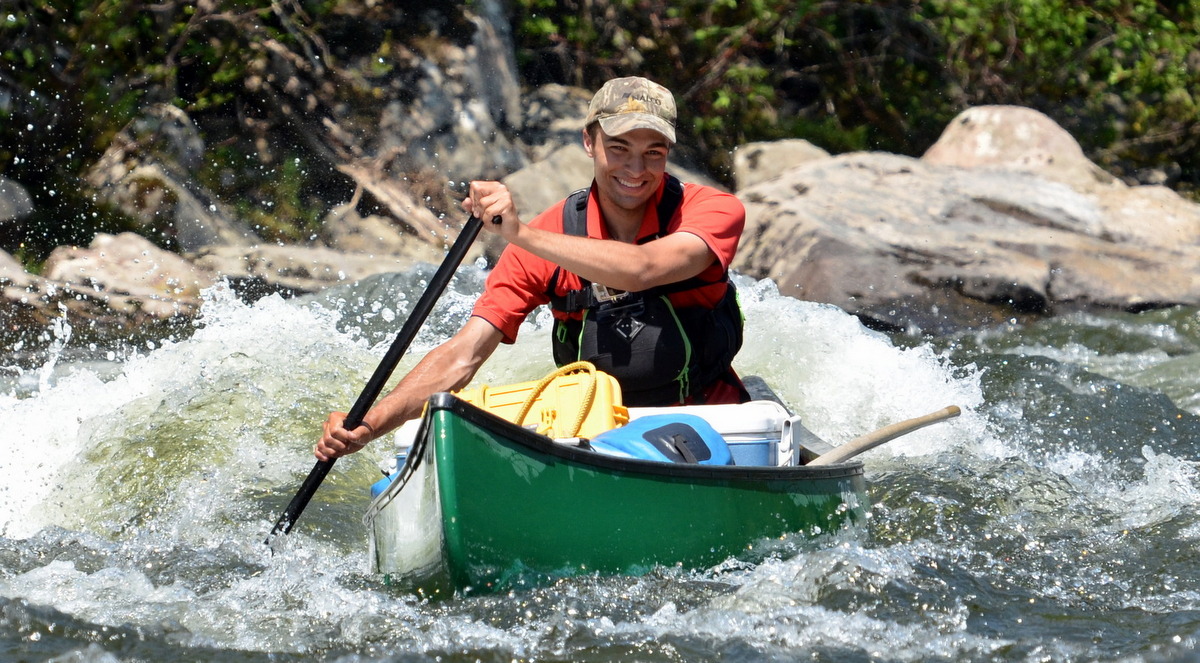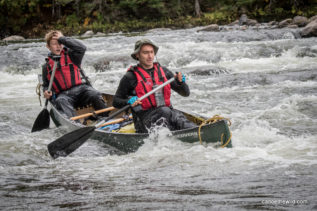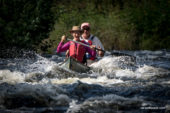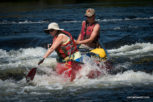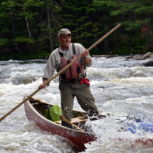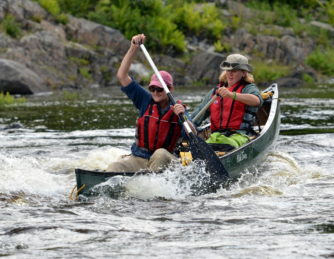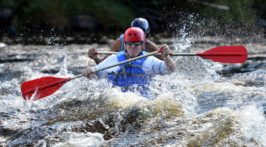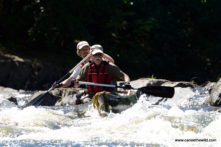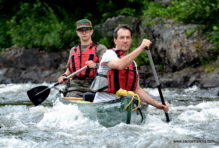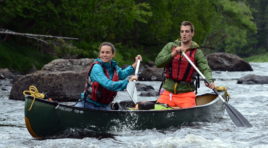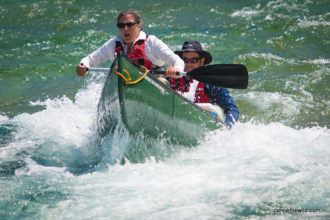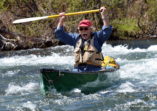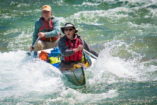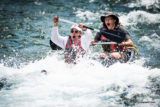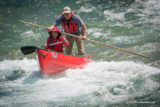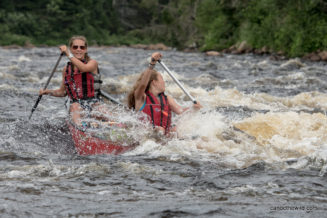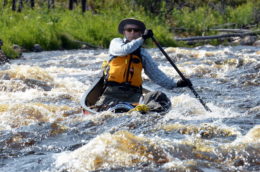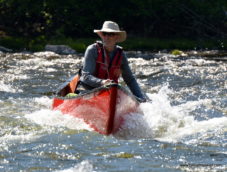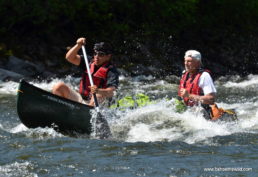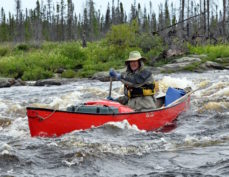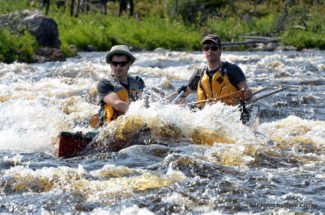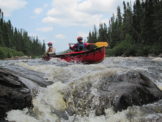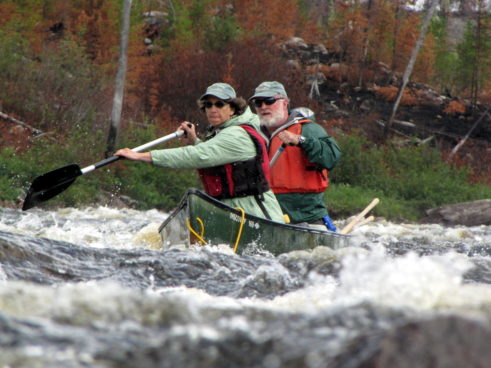Trips that offer Whitewater Canoeing
Maine has numerous rivers that offers fun whitewater. For the beginner, we’ll instruct you on how to properly handle a canoe in moving water. Your confidence will grow as will your desire for future trips with more rapids. We offer numerous trips in Maine and Canada with varying degrees of whitewater.
Maine Whitewater Canoeing Trips
St. Croix River
1-5 days
Designated as a Canadian Heritage River, the St. Croix flows along the eastern Maine border with New Brunswick. Canada offers great wilderness scenery, moderate whitewater (class I-II), maintained campsites, and fishing for small mouth Bass.
The St Croix is well suited for families and groups of all ages with little or no experience and can be paddled all summer long. (more about St. Croix River trips)
Webster Stream
3-4 days
Starting in the Allagash Wilderness Waterway at the Chamberlain Thoroughfare or Telos Landing, we sneak out the ‘back door’ of the Allagash via the Telos Cut. Below Telos Lake. We paddle the mile long Telos Cut to Webster Lake.
It is 3 miles across Webster Lake and 6.5 miles to Indian Carry, a ledge drop that we usually line or portage. The next 2 miles to Grand Pitch has several rapids that can be paddled or carried. Grand Pitch is a mandatory 1/2 mile portage. Shortly after is Grand Lake Matagamon.
It is 8.25 miles down lake to the Daml or take out at a landing near the north entrance to Baxter State Park. (more about Webster Stream trips)
Penobscot River – East Branch
3 days
Below the Grand Lake Matagamon dam is the scenic and rugged East Branch of the Penobscot River canoe trip with views of the Traveler Mountains to the west in Baxter State Park.
It is a 27-mile trip to Whetstone Falls with several mandatory portages around falls including Haskell Rock Pitch, Pond Pitch, Grand Pitch and Hauling Machine Pitch. Being in good physical condition for the portages is important. (more about Penobscot River – East Branch trips)
Machias River
3-6 days
With the feel of a northern river, this scenic and wild river is downeast whitewater canoeing and camping at its finest!
The Machias River is less traveled then the Allagash, Penobscot, and Saint John Rivers, and easier to access. The headwaters offer a series of scenic lakes and marshes, while the river offers numerous rapids, ledge drops, and several portages around falls.
Run early May to early June and be sure to check for appropriate water levels prior to going. (more about the Machias River canoe trips)
St. John River
7 days
One of Maine’s finest remote canoe trips, the Saint John River flows 128 miles from its headwaters (Saint John Ponds) and meets up with the Allagash River just below the town of Dickey.
The trip from Baker Lake to the Town of Dickey is 105 miles and can be done in six or seven days. Later in the trip, we’ll take on mile long Big Black Rapids. 24 miles downstream from the Big Black Rapids and near trip’s end we’ll take on Big Rapids, which are 2 miles long.
Run mid May through mid June, (more about the St. John River canoe trips)
Maine Whitewater Canoeing Pictures
Canada Whitewater Canoeing Trips
Bonaventure River, Quebec
7 days
One of Eastern Canada’s finest rivers, the Bonaventure is an excellent river to paddle that is not too physically demanding, although good paddling skills are required.
The Bonaventure starts out as a swift moving mountain stream with many sharp turns (use caution with multiple strainers!) growing in size as we descend through a valley of black spruce. The views of the surrounding hills are spectacular.
On day 4 or 5 we are in the gorge with several ledge drops and numerous class II rapids. After the gorge, the river is much wider and we paddle over many beautiful salmon pools on our way to the Bay of Chaleur. (more about the Bonaventure River canoe trip)
Cascapedia River, Gaspe, Quebec
4-5 days
The Cascapedia is a great river trip for those looking for a shorter and easier whitewater canoeing trip then the Bonaventure. Beginning south of the Chic Choc Mountains and west of the Bonaventure, we spend four days paddling lively and fun, but not too intimidating whitewater including numerous class I and II rapids. Approximate distance by canoe is 50 miles, available in June. (more info)
NE Mistissibi River, Quebec
10-12 days
The NE Mistissibi River is one of Eastern Canada’s best whitewater canoe trips with over 80 sets of rapids in 80 miles, many over 1 kilometer in length.
There is only one short portage and several linings, making this an excellent river to paddle that is not too physically demanding. Scouting rapids before running provides helpful instruction on how & where to run.
There will be time to fish for brook trout and northern pike and for relaxing on the shores of this magnificent river in this remote wilderness region. (more about the NE Mistissibi canoe trip)
The de Pas River, Quebec
14-17 days
The de Pas River is located in northern Quebec above the 55th Parallel northeast of Labrador City and east of Schefferville.
A tributary to the George River, the De Pas begins with numerous headwater lakes and flows northeast to the George River. This is an excellent back country canoeing and camping adventure offering fabulous fishing for brook trout & northern pike, with the possibility of spotting wolves and caribou. There are several options for your trip.
We can start by crossing Attikamagen Lake (near Schefferville) and paddle just the headwater lakes ending on a tributary (approx. 55 miles by canoe and 9 days later). Another option is skipping the headwater lakes by flying into a tributary to the de Pas, spending a few days exploring and fishing, then paddling to the George (approx. 100 miles and 9 days).
All options involve flying back to Schefferville by bush plane. We will utilize the services of a local outfitter for our trip. (more about the de Pas River canoe trip)
Canada Whitewater Canoe Pictures
Classification of Rapids
Class I: Fast moving water with riffles and small waves. Passage clear, no serious obstacles, all obvious and can be easily missed with little training.
Class II: Straightforward rapids with wide, clear channels that are evident without scouting. Occasional maneuvering required, rocks and medium sized waves are easily missed by trained paddlers.
Class III: Rapids with moderate, irregular waves that may be difficult to avoid and can swamp an open canoe. Complex maneuvers in fast current and good boat control are often required.
Note: Classification descriptions are condensed. A full description of rapid classification can be found in the Maine AMC River Guide. When doing whitewater trips on your own, it’s your responsibility to do your homework, know your route, best times to go and be properly trained and experienced in whitewater canoeing and remote wilderness camping.
